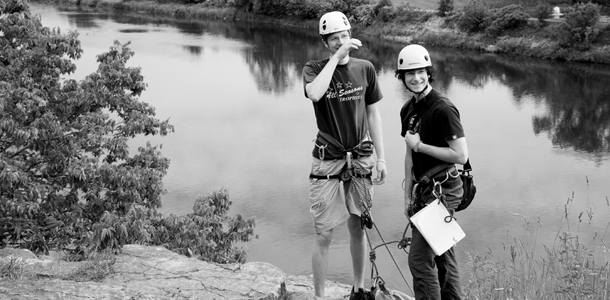
The rare Charitable Research Reserve is ideally suited for research for a variety of reasons including:
Size and Diversity of Habitats
Our 900+ acres encompass a broad range of habitats including an eight-kilometre long riparian zone along the Speed River, Grand River (a Canadian Heritage River) and its associated islands. There are also three coldwater steams that flow through rare and several swamp habitats in forest tracts. Other forested habitat includes upland and lowland deciduous forest, old-growth Carolinian forest as well as hawthorn and bur oak savanna. One of the region’s few exposed cliff faces stretches along the Grand River above a neighbouring floodplain meadows. Agricultural lands include old fields, organic fields, and fields currently farmed conventionally, as well as an extensive system of hedgerows.
Flora and Fauna
There is a high diversity of organisms at rare that either live on the reserve or pass through it during migration. Our devoted volunteers and environmental advisors have spent years cataloguing rare’s flora and fauna and compiling species lists for the reserve. As well, rare has implemented Ecological Monitoring and Assessment Network (EMAN) protocols for monitoring salamanders, butterflies, benthic invertebrates, lichen, forest health and forest soils that have also shed light on biodiversity at rare. To date, this biodiversity includes over 200 bird species, over 800 plant species, 73 moss and liverwort species, 269 species of fungi, 13 amphibian species, 8 reptile species, 77 species of butterflies, 3 species of fish in the coldwater streams and 31 mammal species; including humans who have lived on the land for 9,500 years.
Proximity to Leading Universities
The University of Waterloo, Wilfrid Laurier University, McMaster University and the University of Guelph are all located within an hour’s drive of rare. One of the principal challenges researchers face is the logistics and cost involved with conducting research in isolated locations. Equipment and personnel need to be transported to these sites and personnel need to be accommodated with food and shelter. Without ready access to university lab facilities, researchers must establish portable laboratories at an added cost. Researchers at these universities could access their research sites from the comfort of their homes. For researchers at other universities, on-site accommodations are available.
Climate of Cooperation
Research is one of the fundamental goals of rare and one our core programs; the Chain of Learning seeks to connect the research being completed on our reserve with our educational programs. Our Program Scientist is available to assist you in learning more about rare and determining if rare would be a suitable field site for your research. Accommodations and lab space are available on-site, currently free of charge for any graduate student.
Restoration Plans
One of rare’s long-term goals is to restore some of the land currently under agricultural production. These goals specifically include the restoration of riparian habitat, reconnecting forested habitat and allowing hedgerow habitat to expand to create a rich forested landscape with a series of open spaces nestled within it. The opportunities are many and varied for researchers to use rare as a template for restoration ecology initiatives: from collecting baseline data to monitoring the effects of regeneration or active restoration. These opportunities exist in a broad spectrum of disciplines including Indigenous knowledge, soil science, ecology, mycology, and plant biology.
Long-Term Vision
The feasibility of conducting long-term research projects and monitoring initiatives can be problematic on some lands if the political climate shifts and/or the reserve changes hands. The rare Charitable Research Reserve was established as a charity in 2001 with the goal of keeping 913 acres along the Grand River intact in perpetuity and using the reserve for education and research programs. For this reason, rare is ideally suited for long-term research projects that require stability.
Proximity to Urban Areas
The rare Charitable Research Reserve is one of Canada’s largest urban green spaces. Studying the structure and function of these ecosystems can contribute to our understanding of southern Ontario before the arrival of European settlers. The natural areas of rare are templates for ecological restoration efforts in the surrounding region.
If you are interested in researching at rare please contact:
Research Department
rare Charitable Research Reserve
1679 Blair Road
Cambridge, ON N3H 4R8
or at 519-650-9336
